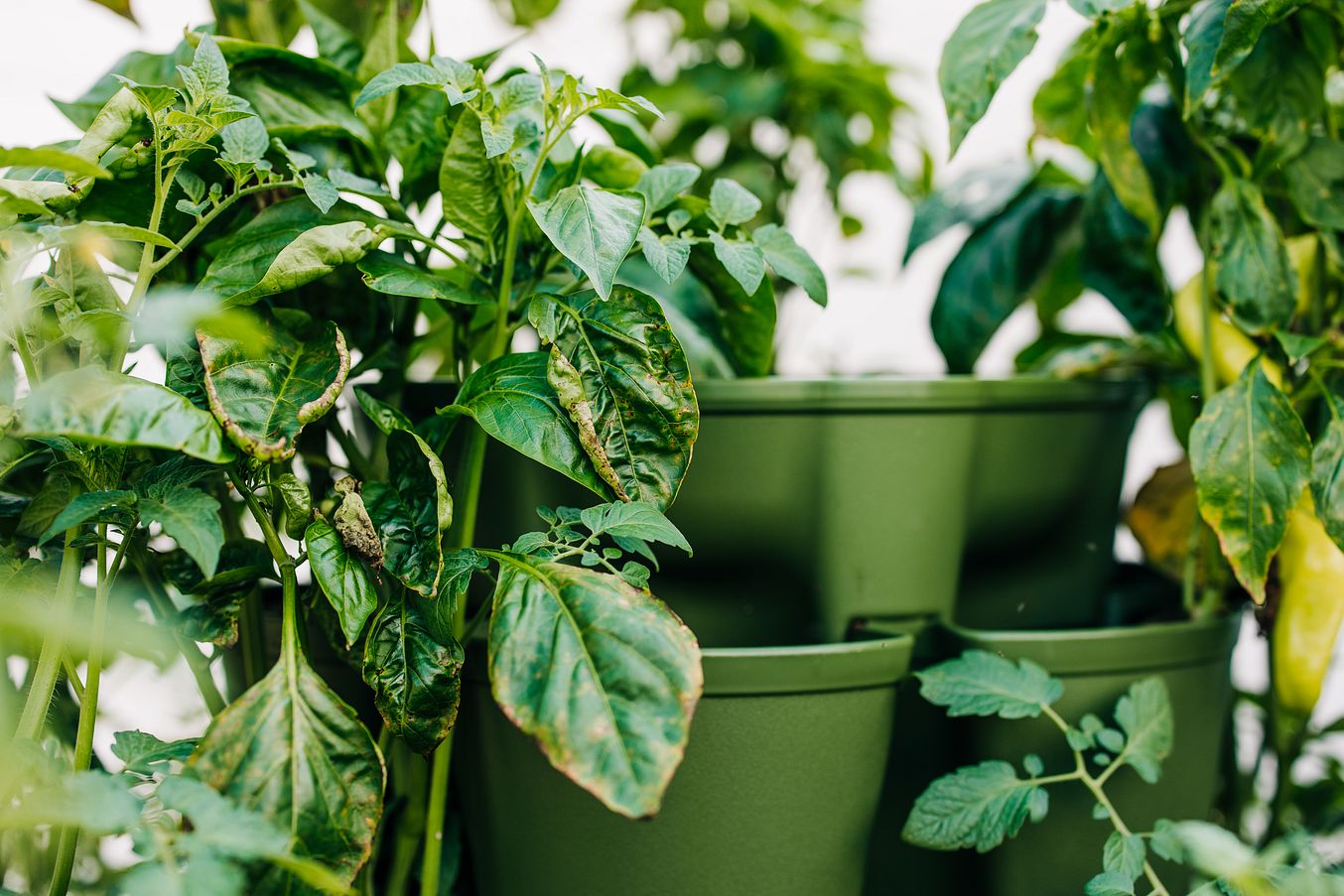A proactive guide to spotting, stopping, and minimizing disease issues in container gardens
Your Garden’s First Aid Kit
When our garden starts to show signs of stress, it’s easy to assume the worst. But in most cases, the cause is common — and fixable. This straightforward guide will help you diagnose common diseases that impact container gardens and apply reliable treatments, becoming a more confident and knowledgeable gardener over time.
Powdery Mildew: The Usual Suspect in a Crowd
What it looks like : White, powdery coating on leaves — especially older, shaded ones.
Why it happens : High humidity and poor airflow give this fungal disease a foothold.
Common in : Peas, cucumbers, squash, strawberries, basil.
What to do :
Remove infected leaves before it spreads.
Rotate your planter regularly using the GreenStalk Ultimate Spinner Base to improve air circulation.
Spray with a ready-made Neem oil (or follow the directions on the concentrate to mix your own) every 7–10 days during active infection.
Note on Neem oil: It can blister some plants, so follow directions and test a leaf. Apply in the early morning or late evening to avoid full sun risking a burn.
Tip: Powdery mildew doesn’t love dry, breezy spaces, so thinning overcrowded pockets goes a long way to prevent it from settling in.

Early Blight: Trouble You Can’t Ignore
What it looks like : Brown bullseye-shaped spots on lower leaves; yellowing follows.
Why it happens : Fungal spores can be airborne and splash from soil to leaf.
Common in : Tomatoes and potatoes.
What to do :
Prune off the bottom 6 - 8 inches of foliage on tomato plants.
Spray with neem oil or apply solution weekly to slow the spread.
Avoid overhead watering and ensure the plants are getting plenty of sun.
If over 50% of the plant is infected, it may be time to pull it and start fresh.
Bacterial Leaf Spot: Speckles That Spread Fast
What it looks like : Tiny, water-soaked spots that turn black or brown, often with yellow halos.
Why it happens : Moisture + warm weather + bacteria = rapid spread. Often enters via tools, splashing water, or wind.
Common in : Peppers, tomatoes, leafy greens.
What to do :
In early stages, copper-based sprays can help suppress the spread. Use only as needed and follow label instructions carefully.
Sanitize pruners and harvest scissors between plants throughout the season, and especially if disease may be present. Master Gardeners use a 1:10 ratio of bleach to water.
Remove infected leaves and harvest regularly to thin foliage for future prevention.
Root Rot: Hidden Below the Surface
What it looks like : Leaves wilt and yellow even with regular watering. Your soil may smell sour, and uncovering roots may reveal them to be brown or slimy.
Why it happens : Overwatering, poor drainage, or compacted soil creates an anaerobic environment where fungi thrive.
Common in : Lettuce, strawberries, herbs, and tiered pockets not draining correctly.
What to do :
Try a diluted hydrogen peroxide soil drench (1 part 3% hydrogen peroxide to 3 parts water) once a week to oxygenate the soil and reduce fungal pressure.
If the hydrogen peroxide soil drench doesn’t help, gently remove the plant from its pocket, clear soil off the roots, and replant with fresh soil, lightly moistened.
Avoid watering again until the top 2 inches are dry to the touch.
Check out our Soil Health Guide for more tips on rebuilding your growing medium.

Downy Mildew: A Cool-Weather Creeper
What it looks like : Yellow blotches on the top of leaves, gray mold on the undersides.
Why it happens : Cool nights, heavy dew, and still air.
Common in : Basil, spinach, lettuce.
What to do :
Harvest often and trim lower leaves when possible to improve airflow.
Use the GreenStalk Insect + Frost Protection Cover to shield plants from overnight moisture.
Don’t compost affected leaves. Remove and dispose of promptly to prevent the spread.
Note: This mildew isn’t related to powdery mildew — it’s caused by a completely different organism and thrives in very different conditions.
Fusarium Wilt: The Slow Fade
What it looks like : One side of the plant wilts while the other looks fine. Eventually, the whole plant collapses.
Why it happens : A soil-borne fungus that enters through roots and blocks water movement internally.
Common in : Tomatoes, basil, beans.
What to do :
Remove the entire plant, including the root system.
Don’t reuse soil from affected pockets — start fresh.
Rotate crops seasonally (don’t plant tomatoes in the same pocket twice in a row).
Consider a biological fungicide (like Mycostop) applied at planting in future seasons to help protect roots.
Curious gardeners can slice the stem open lengthwise and look for brown streaks in the core. Classic Fusarium.
When to Let Go
Sometimes the best thing you can do is start over.

Signs it’s time to remove a plant :
More than 50% of the plant is affected
The disease is spreading to nearby crops
There’s no improvement after 1 - 2 rounds of treatment
How to safely remove a sick plant :
Diagnose the plant’s ailment using the information above.
Bag and dispose soil and full plant with root ball — don’t compost diseased material.
For best results, gently remove all other plants from that tier (even if unaffected) so you can dispose of all potentially infected soil.
Empty and wash the planter tier. Refresh the soil before transplanting rescues and installing new plants.
If you’re using the GreenStalk Spring Watering System , rinse out the reservoir and check the system for any complications.
Think of this guide as your garden first aid kit. Whether you’re mid-season or just getting started, strong soil, consistent watering, and simple treatments can go a long way. Fertilizing regularly gives your plants the fuel they need to bounce back, resist infection, and keep growing strong. Bookmark this guide and come back if your garden needs some extra care.












